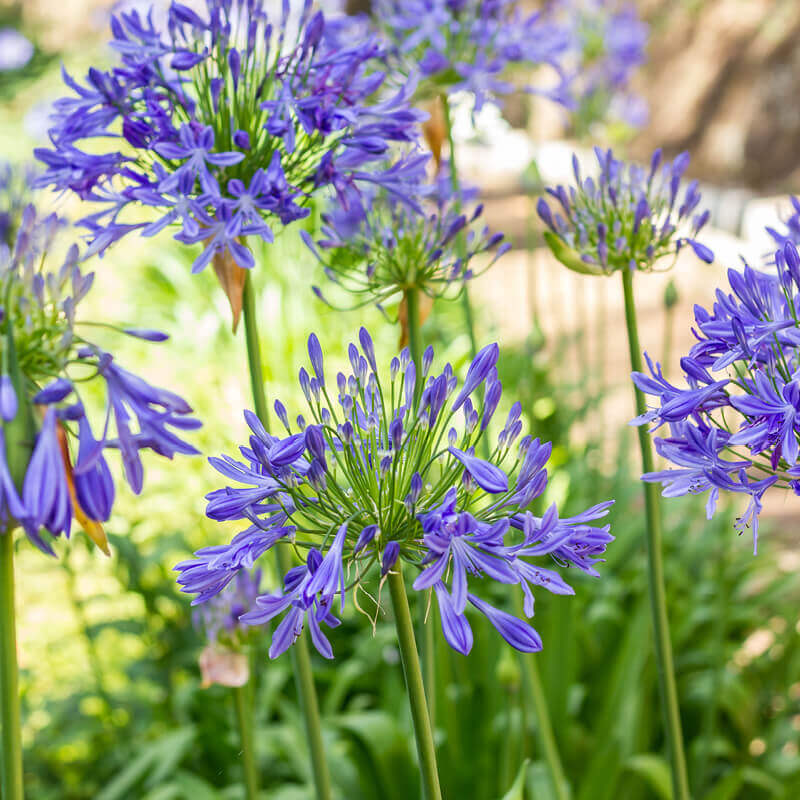Agapanthus Friend Plant Kingdoms: Perfect Pairings for Your Garden
Agapanthus Friend Plant Kingdoms: Perfect Pairings for Your Garden
Blog Article
Grasping the Art of Agapanthus Treatment: Crucial Steps for Healthy Development and Dynamic Blossoms
In the realm of cultivation, the cultivation of agapanthus stands as a rewarding endeavor for those who seek to nurture these sophisticated blooming plants. With their striking flowers and graceful foliage, agapanthus has caught the attention of gardeners worldwide. Nevertheless, achieving ideal development and vibrant blooms needs a nuanced method that encompasses numerous important steps. From choosing the appropriate selection to understanding trimming strategies, the trip in the direction of growing thriving agapanthus plants is multifaceted and holds the key to unlocking the full capacity of these botanical gems.

Choosing the Right Agapanthus Range

When picking the appropriate Agapanthus variety for your garden, think about factors such as environment suitability, flower shade, and development behavior. Additionally, take into consideration the environment in your area to make sure the Agapanthus variety you choose can thrive in your specific conditions. Understanding the development behavior of different Agapanthus ranges is critical for appropriate positioning within your yard.
Ideal Planting Problems
Thinking about the ideal environmental needs is important for effective Agapanthus farming. Agapanthus thrives in well-draining soil with a slightly acidic to neutral pH level. When planting, pick a place that receives complete sunshine to partial shade. In hotter environments, providing some afternoon color can protect against scorching of the leaves. Agapanthus plants are delicate to cool temperatures and need to be shielded from frost during wintertime months.
To make certain healthy and balanced development and vibrant blooms, plant Agapanthus light bulbs at a deepness of regarding 2-4 inches and area them 8-12 inches apart. Adding raw material, such as compost, to the soil can improve water drainage and fertility, advertising durable origin growth. Mulching around the base of the plants assists maintain dampness and reduces weed growth. Normal watering is critical, especially throughout the growing season, to maintain the dirt constantly moist however not waterlogged.
Watering and Fertilizing Tips
Maintaining proper dampness levels and providing important nutrients are crucial elements in the treatment routine for Agapanthus plants. It is essential to strike a balance when it comes to sprinkling Agapanthus. These plants like consistently wet dirt yet are prone to root rot if overwatered. During the expanding season, water deeply once a week, making certain the dirt is well-draining to avoid waterlogging. In hotter climates or throughout durations of dry spell, even more constant watering might be required to maintain the dirt evenly moist. Nonetheless, lower watering in the wintertime to prevent water logged conditions.
Feeding Agapanthus is essential for promoting healthy growth and respected blooms. Use a balanced fertilizer, such as a 10-10-10 formula, in the very early springtime as brand-new growth emerges. Repeat this application every 6-8 weeks throughout the expanding season. Avoid too much fertilization, as it can result in lavish vegetation at the expenditure of blooms. Always follow the producer's instructions for appropriate dilution and application methods. By adhering to these watering and fertilizing suggestions, you can ensure your Agapanthus plants grow and create lively, durable blooms.
Trimming Strategies for Agapanthus
Trimming Agapanthus plants at the suitable times check my reference and with appropriate methods is important for preserving their health and promoting optimum development and flowering. The excellent time to prune Agapanthus is in late winter season or early springtime before brand-new development arises.
For flowered stems, wait up until the blossoms have actually perished and after that trim them back to the base. This not only tidies up the plant's appearance yet additionally encourages the advancement of brand-new flower buds. Deadheading spent flowers can additionally reroute the plant's energy into creating more blossoms as opposed to setting seeds. However, if you wish to collect seeds for proliferation, find out here leave some blossoms to dry and mature on the plant.
Remember to utilize tidy, sharp tools to make accurate cuts and decrease the risk of presenting diseases. Agapanthus. Regular pruning will help maintain your Agapanthus looking healthy and balanced and neat while ensuring an abundant screen of stunning blossoms
Taking Care Of Typical Pests and Conditions
After making certain appropriate trimming strategies for Agapanthus, it is important to attend to common bugs and illness that can influence the wellness and vigor of these plants. One common parasite that affects Agapanthus is the Agapanthus gall midge.
In addition, Agapanthus plants can suffer from origin rot if they are grown in inadequately draining pipes dirt. By being watchful and taking punctual action against pests and diseases, you can aid your Agapanthus plants prosper and produce dynamic flowers. Agapanthus.

Verdict
Finally, grasping the art of agapanthus care entails selecting the right selection, providing ideal growing conditions, proper watering and next page fertilizing, proper pruning methods, and addressing usual parasites and conditions. By adhering to these important steps, you can guarantee healthy growth and dynamic blooms for your agapanthus plants. Keep in mind to on a regular basis check and preserve your plants to advertise their general wellness and longevity.
To guarantee healthy development and lively flowers, plant Agapanthus light bulbs at a depth of concerning 2-4 inches and area them 8-12 inches apart. By complying with these watering and fertilizing suggestions, you can ensure your Agapanthus plants thrive and produce dynamic, long-lasting blooms.
One usual insect that influences Agapanthus is the Agapanthus gall midget. In addition, Agapanthus plants can experience from root rot if they are planted in inadequately draining soil. By complying with these necessary steps, you can make sure healthy and balanced development and vibrant blooms for your agapanthus plants.
Report this page